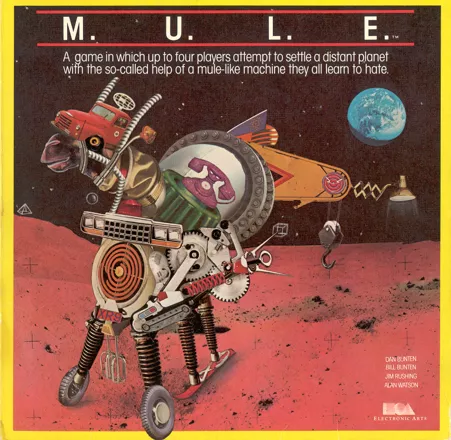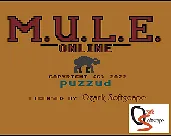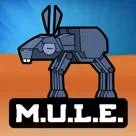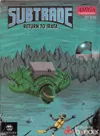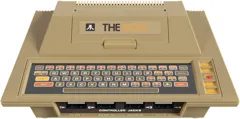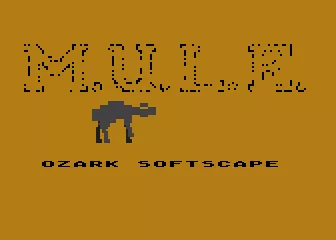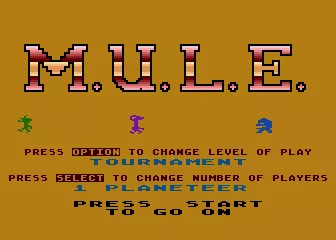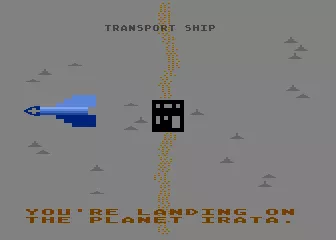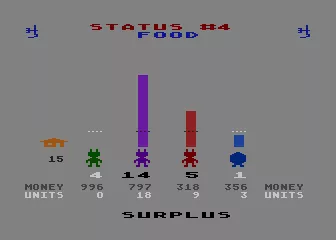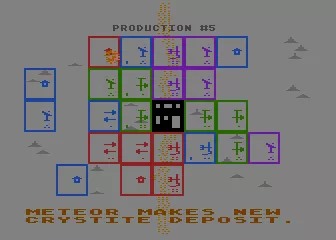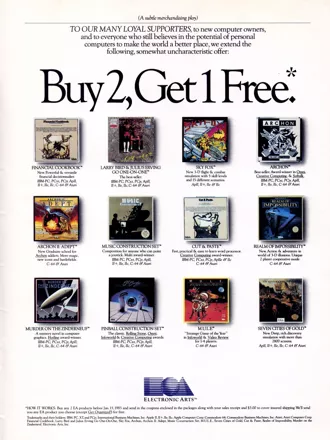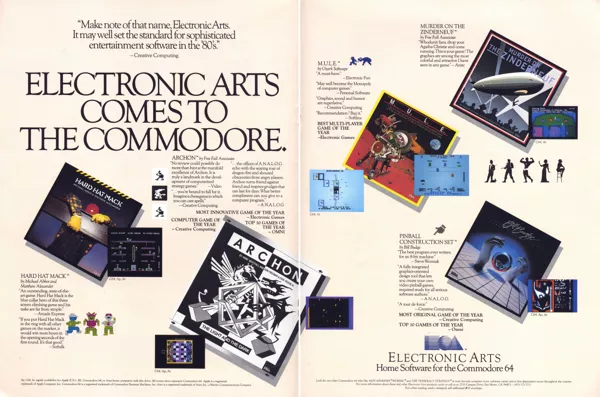M.U.L.E.
Description official descriptions
M.U.L.E. is about four hopeful explorers trying to make a fortune on a virgin planet. This is done by producing various goods (Food, Energy, Smithore, Crystite). Each of these goods have their uses: if you don't have enough food, you will have less time during your turn. If you don't have enough energy, your output will be lower. If enough smithore isn't produced, there will be a shortage of M.U.L.E.s. Crystite is the big earner that can make or break your game.
You start the game by selecting your race. Some are easier to play, some harder. There are three levels of difficulty, in the easiest the game only lasts 6 turns, but the real game is 12 turns. Crystite is not available at the easiest level.
Each turn starts with a land claim. Each player gets to choose a spot of land for themselves from the map. If two players choose the same spot, the player with less money wins. The map consists of different landscapes. River is best for producing food, plains for energy, mountains for smithore. Crystite is hidden and must be first found by taking a land sample to the town.
After the land claim, each player takes turns in cultivating their land and doing other tasks. They can buy M.U.L.E.s to start production on their land, sabotage other players by buying M.U.L.E.s and letting them loose, try to catch the Wumpus for cash and try to find crystite veins. The time to do these things depends on if the player has enough food. Finally the player goes to the casino and wins a small amount of money, depending on how much time was left.
After the cultivation phase is the production phase where each land produces an amount of goods depending on a number of factors such as if the player has enough energy in storage, what type of land is used, and some random events such as sunspots that increase energy output. Also, if the same player has plots producing the same goods next to each other, they gain a bonus. Three plots of the same production type anywhere on the map by the same player also gives a bonus.
Third phase is the auction. Here the players buy and sell their goods on the open market. Players negotiate the price by moving up and down on the screen. The shop also has prices that depend on how abundant or scarce the goods are. So if there is a shortage of food, the price goes up and vice versa. This allows for various tactics, especially if one player manages to monopolize food, energy or smithore production. If there is no food, others don't have time to change their production types, if there is a shortage of energy, their land won't produce and if there are no M.U.L.E.s they can't change production type on their plot. Hoarding goods also has a drawback in the form of surplus where each turn a percentage of goods is wasted.
There are a number of random events in the game. Some affect one player, usually the one winning gets small penalties and the losing player(s) get small rewards. The big events that happen randomly are:
-
M.U.L.E. goes crazy - the M.U.L.E. on one of the plots runs away losing production for that round plus the money to replace it.
-
Planetquake - production of smithore and crystite is much lower.
-
Fire in store - all stock in the shops are destroyed (which means prices will skyrocket, but if you needed to buy something, you are at the mercy of other players).
-
Pirate attack - pirates steal all crystite from stores and players (in the easiest level they steal smithore). Nasty if you happened to have a lot of them waiting for better prices.
-
Acid rain storm - affects the plot under the storm and below it by boosting food production and decreasing energy production.
-
Sunspot activity - increases energy production.
-
Pest attack - eats all food on one plot.
-
Meteor strike - destroys the M.U.L.E on the plot it strikes but creates a very rich crystite plot.
The game always has four players, with 1-4 human players possible and the rest played by the AI. Because the players only need two buttons at most (up/down) in auction, it's easy to play with four people around the computer.
Groups +
Screenshots
Promos
Credits (Commodore 64 version)
12 People
| Game Design |
|
| Execution |
|
| Package Design | |
| Liner Notes | |
| Photography | |
| Package Art | |
| Producer | |
| Music by | |
| Manual writing |
|
| Manual design |
|
Reviews
Critics
Average score: 80% (based on 14 ratings)
Players
Average score: 3.6 out of 5 (based on 63 ratings with 4 reviews)
The Good
Fun-Factor!! As old as this game is now, it still supplies fun for many ages.
The Bad
For some this game will be too complicated to get into.
The Bottom Line
Let's face it - the graphics are very 80's, and the music is a little cheesy. This being all the more reason to love this game. What the game really has going for it is fun-factor. Rarely does a game let you play computer opponents that continue to surprise you. It combines strategy with some mild gameplay and I have never met a person who has played this game with some length that didn't fall in love and get totally hooked on the game. MULE will never be forgotten.
Commodore 64 · by Jeremy Howe (4) · 2006
Great trading game that inspired multiplayer
The Good
M.U.L.E. was the first game I can remember playing that actually demonstrated how multiplayer game play can actually improve game play. Four guys hunched around the monitor, each trying to outbid the other (but not bid too high), shouting at each other for outbidding them--no other computer game inspired such banter.
The premise of the game was simple to grasp, difficult to master, all the while staying engaging. This is a game I could always keep coming back to. No game was ever the same twice.
The Bad
They graphics for this game were a little weak, even for the era of computers it was released for. But graphics were not the draw for this game, but the excellent gameplay.
The Bottom Line
A great trading game with an engaging premise and gameplay.
Commodore 64 · by Frecklefoot (188) · 2007
The Good
This game is more complex than just about every modern resources management game I have played. It's not complex mathematically. It's complex in the number of strategies you can employ. Many modern games are "fake" complex and force you to understand advanced mathematics to simply model the game. Even after you apply all of these advanced techniques, these modern games are in reality much more simple than MULE.
The Bad
The limitations in graphics and computer memory limited how much they could do in this game. The maps could be larger, the resources more detailed, and the games longer. Modem support would have been great.
The Bottom Line
This is the great grand daddy to all of those 4x strategy and RTS games. MULE set the ground work for the resource management aspects of every modern strategy game. The only thing it didn't have was actual combat.
Commodore 64 · by Sean Johanson (13) · 2009
Discussion
| Subject | By | Date |
|---|---|---|
| Entry fails to note Apple II release of this game | Kevin O'Keeffe | Aug 12, 2010 |
Trivia
1001 Video Games
M.U.L.E. appears in the book 1001 Video Games You Must Play Before You Die by General Editor Tony Mott.
Cancelled successor
Despite the popularity of M.U.L.E. and the game's cult status, an official sequel or remake was never released. At least one version was in development, however. Developed by the German programming team Infernal Byte Systems exclusively for the Amiga, Deluxe M.U.L.E. was in the works in 1990. Aside from updated graphics and sound, the gameplay would remain mostly unchanged, with two exceptions: the terrain would be randomly generated, and players would be able to build weapons arrays to defend against space pirates. Deluxe M.U.L.E. was never released, because of both programming troubles and Electronic Arts revoking the license.
Sources: Power Play magazine 8/90 and 10/92
Inspiration
The game was inspired by the novel Time Enough for Love by writer Robert A. Heinlein. The book describes among others colonists using genetically engineered mules.
References
M.U.L.E. was originally released for the Atari 400/800 home computer system. This fact explains the name of the planet your intrepid planeteers cultivate: IRATA. Spell it backwards. The planet name appears in both the C64 and Atari versions.
Awards
- Computer Gaming World
- March 1988 (Issue #45) – Introduced into the Hall of Fame
- November 1996 (15th anniversary issue) - #3 in the “150 Best Games of All Time” list
- GameSpy
- 2001 – #25 Top Game of All Time
- GameStar (Germany)
- Issue 03/2013 – One of the "Ten Best C64 Games“
Information also contributed by FatherJack, Indra was here, PCGamer77, and Terok Nor
Analytics
Upgrade to MobyPro to view research rankings and price history! (when applicable)
Related Sites +
-
AtariMania (Ariola:UK, UK, Atari 8-bit)
For Atari 8-bit: game entry database; downloadable release; game packaging; advertisement; manuals; magazine reviews; additional material. -
AtariMania (Electronic Arts, USA, Atari 8-bit)
For Atari 8-bit: game entry database; downloadable release; game packaging; advertisement; manuals; magazine reviews; additional material. -
Commodore 64 Boxed Sets
For C64: game packaging digitalisations. Include box, manual, brochure, additional material. -
IMDb, the Internet Movie Database
Game database entry: reviews, trailers, ratings. -
Lemon 64
For Commodore 64: game entry database; advertisement; magazine reviews; music; documentation; cover art; additional material. -
MSX Generation
For MSX: game database entry; game packaging; manuals; additional material. http://www.generation-msx.nl/ -
Museum of Computer Adventure Game History (Ariolasoft, Atari 8-bit)
For Atari 400/800: game packaging; manuals; media; additional material. -
Museum of Computer Adventure Game History (Bullet-Proof Software, MSX)
For MSX: game packaging; manuals; media; additional material. -
Museum of Computer Adventure Game History (C64)
For Commodore 64: game packaging; manuals; media; additional material. -
Museum of Computer Adventure Game History (Mindscape, NES)
For Nintendo: game packaging; manuals; media; additional material.
Identifiers +
Contribute
Are you familiar with this game? Help document and preserve this entry in video game history! If your contribution is approved, you will earn points and be credited as a contributor.
Contributors to this Entry
Game added by Lars Norpchen.
PC Booter added by Trypticon. NES added by Shoddyan. Windows added by Rik Hideto. Sharp X1, MSX added by Kabushi. PC-88, Atari 8-bit added by Terok Nor.
Additional contributors: Alaka, Zaghadka, Patrick Bregger, FatherJack, ZeTomes.
Game added July 19, 2003. Last modified December 19, 2024.


